Optimal Design of Functionally Graded Parts
Abstract
1. Introduction
2. Evolution of Design Methods
2.1. Prior to 2002
2.2. 2003–2009
2.3. 2010–2015
2.4. 2016–2022
3. Homogenization Approaches
3.1. Rule of Mixture
3.2. Mori-Tanaka Scheme
3.3. Levin’s Model
3.4. Maxwell Scheme
3.5. Temperature-Dependent Properties
3.6. Finite Element Model
3.7. Tamura-Tomota-Ozawa Model
4. Representation Techniques
4.1. Voxel-Based Models
4.2. Volume-Mesh Models
4.3. Explicit Function-Based Models
4.4. Control Point-Based Models
4.5. Implicit Function-Based Models
4.6. Composite Models
4.7. Material Primitive-Based Models
4.8. Comparison
5. Finite Element Analysis Approaches
5.1. Commercial Software
5.2. Indigenously-Developed Codes
5.3. FEM Integrated with CAD
6. Optimization Algorithms
7. Most Advanced Design Methods
8. Manufacturing Techniques
8.1. Direct Energy Deposition
8.2. Material Extrusion
8.3. Material Jetting
9. Conclusions and Future Directions
- With the advent of AM, FGM with a complex geometry and material distribution can be fabricated. To get the most out of this, we need advanced methodologies to design and fabricate parts with optimal material distributions and/or geometries.
- The development of a data-driven strategy to complement designers’ creativity and knowledge would be a fascinating area of future work. The first step in establishing a data-driven approach would be to build a massive database of material models and their attributes. The physical and mechanical properties of various combinations of materials in various compositions should be tested and maintained in the database. The database could be used to generate automated suggestions pertaining to the materials to be used for different portions of the designs, the composition of materials to be used, and other topological and geometrical changes to the design using suggestive techniques developed with machine learning and probabilistic models for the CAD domain.
- To analyze and simulate the behavior of more complicated FGM objects, advanced and resilient numerical approaches as well as a representation scheme that facilitates analytical calculations must be devised. Furthermore, having a system that can optimize and recommend relevant adjustments in the design to satisfy and meet the designers’ needs would be quite advantageous. The recommended alterations could take the form of changes to the design’s geometrical characteristics, topology, or material distribution over crucial sections.
- Because the progressive and smooth changing of material constituents is a major aspect of FGMs, the most common design variable in the examined studies was the material distribution pattern. The manufacturability of the FG structure was taken into consideration in a few optimization experiments. It’s a good idea to include manufacturability in the optimization studies because it leads to more practical designs with a better chance of being mass produced.
- So far, several AM technologies have been proposed to manufacture FGMs. Real-world industrial applications, on the other hand, are still few and far between, necessitating major and thorough research efforts to address the vast array of concerns and obstacles involved. As new functional materials with complicated compositions arise, new sophisticated manufacturing technologies, including new procedures for the fabrication of FGMs, must be developed. Micro-nano additive manufacturing (sometimes referred to as micro-nano scale 3D printing) is a new processing technique for producing sophisticated micro-nano structures. High aspect ratio micro-nano structures, multi-lateral micro-nano structures, macro/micro-composite structures, and embedded hetero-structures are all possible using FGAM.
Author Contributions
Funding
Institutional Review Board Statement
Data Availability Statement
Conflicts of Interest
Nomenclature
| DED | direct energy deposition | ||
| DLMD | direct laser metal deposition | ||
| Symbols | DMSh | direct multi-search | |
| E | Young’s modulus | DNN | deep neural network |
| Et | tangent modulus | EFG | element-free Galerkin |
| K | bulk modulus | FA | firefly algorithm |
| k | thermal conductivity | FDM | finite difference method |
| P | material properties | FEA | finite element analysis |
| q | ratio of stress to strain transfer | FEM | finite element method |
| sy | yield strength | FG | functionally graded |
| T | temperature | FGM | functionally graded materials |
| V | volume fraction | FGS | functionally graded sandwich |
| FSDT | first-order shear deformation theory | ||
| Greek letters | GA | genetic algorithm | |
| α | coefficient of thermal expansion | HAP | hydroxyapatite |
| µ | shear modulus | HSDT | higher-order shear deformation theory |
| ν | Poisson’s ratio | IGA | isogeometric analysis |
| ε | strain | IMD | isogeometric multi-mesh design |
| σ | stress | LMD | laser metal deposition |
| MAT | medial axis transform | ||
| Abbreviations | mSOS | modified symbiotic organisms search | |
| AEH | asymptotic expansion homogenization | NSGA | non-dominated sorting genetic algorithm |
| AHEFA | adaptive hybrid evolutionary firefly algorithm | NURBS | non-uniform rational B-splines |
| AM | additive manufacturing | PSO | particle swarm optimization |
| ANN | artificial neural network | RVE | representative volume element |
| BFG | bidirectional functionally graded | SA | simulated annealing |
| CAMD | continuous approximation of material distribution | SOS | symbiotic organism search |
| CPU | central processing unit | SQP | sequential quadratic programming |
| CSG | constructive solid geometry | TSDT | third-order shear deformation theory |
| CT | computerized tomography | X-FEM | extended finite element method |
| CUF | Carrera’s unified formulation | ||
| DE | differential evolution | ||
References
- Inácio, P.L.; Camacho, E.F.; Schell, N.; Fernandes, F.B.; Oliveira, J.; Santos, T.G. Production and characterization of functionally graded NiTi shape memory alloys by Joule effect. J. Mater. Process. Technol. 2020, 285, 116803. [Google Scholar] [CrossRef]
- Rodrigues, T.A.; Bairrão, N.; Farias, F.W.C.; Shamsolhodaei, A.; Shen, J.; Zhou, N.; Maawad, E.; Schell, N.; Santos, T.G.; Oliveira, J. Steel-copper functionally graded material produced by twin-wire and arc additive manufacturing (T-WAAM). Mater. Des. 2021, 213, 110270. [Google Scholar] [CrossRef]
- Torquato, S. Random Heterogeneous Materials; Springer: Berlin/Heidelberg, Germany, 2002. [Google Scholar] [CrossRef]
- Swaminathan, K.; Naveenkumar, D.T.; Zenkour, A.M.; Carrera, E. Stress, vibration and buckling analyses of FGM plates—A state-of-the-art review. Compos. Struct. 2015, 120, 10–31. [Google Scholar] [CrossRef]
- Lewis, R.W.; Ravindren, K. Finite element simulation of metal casting. Int. J. Numer. Methods Eng. 2000, 47, 29–59. [Google Scholar] [CrossRef]
- Koizumi, M. FGM activities in Japan. Compos. Part B Eng. 1997, 28, 1–4. [Google Scholar] [CrossRef]
- Erdogan, F. Fracture mechanics of functionally graded materials. Compos. Eng. 1995, 5, 753–770. [Google Scholar] [CrossRef]
- Naebe, M.; Shirvanimoghaddam, K. Functionally graded materials: A review of fabrication and properties. Appl. Mater. Today 2016, 5, 223–245. [Google Scholar] [CrossRef]
- Liew, K.; Lei, Z.; Zhang, L. Mechanical analysis of functionally graded carbon nanotube reinforced composites: A review. Compos. Struct. 2015, 120, 90–97. [Google Scholar] [CrossRef]
- Jha, D.K.; Kant, T.; Singh, R.K. A critical review of recent research on functionally graded plates. Compos. Struct. 2013, 96, 833–849. [Google Scholar] [CrossRef]
- Reddy, J. Microstructure-dependent couple stress theories of functionally graded beams. J. Mech. Phys. Solids 2011, 59, 2382–2399. [Google Scholar] [CrossRef]
- Asghari, M.; Ahmadian, M.; Kahrobaiyan, M.; Rahaeifard, M. On the size-dependent behavior of functionally graded micro-beams. Mater. Des. 2010, 31, 2324–2329. [Google Scholar] [CrossRef]
- Birman, V.; Byrd, L.W. Modeling and Analysis of Functionally Graded Materials and Structures. Appl. Mech. Rev. 2007, 60, 195–216. [Google Scholar] [CrossRef]
- Kieback, B.; Neubrand, A.; Riedel, H. Processing techniques for functionally graded materials. Mater. Sci. Eng. A 2003, 362, 81–106. [Google Scholar] [CrossRef]
- Vaezi, M.; Chianrabutra, S.; Mellor, B.; Yang, S. Multiple material additive manufacturing—Part 1: A review. Virtual Phys. Prototyp. 2013, 8, 19–50. [Google Scholar] [CrossRef]
- Ngo, T.D.; Kashani, A.; Imbalzano, G.; Nguyen, K.T.Q.; Hui, D. Additive Manufacturing (3D Printing): A Review of Materials, Methods, Applications and Challenges. Compos. Part B Eng. 2018, 143, 172–196. [Google Scholar] [CrossRef]
- Li, Y.; Feng, Z.; Hao, L.; Huang, L.; Xin, C.; Wang, Y.; Bilotti, E.; Essa, K.; Zhang, H.; Li, Z.; et al. A Review on Functionally Graded Materials and Structures via Additive Manufacturing: From Multi-Scale Design to Versatile Functional Properties. Adv. Mater. Technol. 2020, 5. [Google Scholar] [CrossRef]
- Kou, X.; Tan, S. Heterogeneous object modeling: A review. Comput. Des. 2007, 39, 284–301. [Google Scholar] [CrossRef]
- Mortensen, A.; Suresh, S. Functionally graded metals and metal-ceramic composites: Part 1 Processing. Int. Mater. Rev. 1995, 40, 239–265. [Google Scholar] [CrossRef]
- Suresh, S.; Mortensen, A. Functionally graded metals and metal-ceramic composites: Part 2 Thermomechanical behaviour. Int. Mater. Rev. 1997, 42, 85–116. [Google Scholar] [CrossRef]
- Bever, M.B.; Duwez, P.E. Gradients in composite materials. Mater. Sci. Eng. 1972, 10, 1–8. [Google Scholar] [CrossRef]
- Shen, M.; Bever, M.B. Gradients in polymeric materials. J. Mater. Sci. 1972, 7, 741–746. [Google Scholar] [CrossRef]
- Koizumi, M. The Concept of FGM, in second International Symposium on functionally gradient materials (ed. Holt, J.B., Koizumi, M., Hirai, T. and Munir, Z.A.). J. Am. Ceram. Soc. 1992, 3–10. [Google Scholar]
- Koizumi, M.; Niino, M. Overview of FGM Research in Japan. MRS Bull. 1995, 20, 19–21. [Google Scholar] [CrossRef]
- Uemura, S. The Activities of FGM on New Application. Mater. Sci. Forum 2003, 423–425, 1–10. [Google Scholar] [CrossRef]
- Saleh, B.; Jiang, J.; Fathi, R.; Al-Hababi, T.; Xu, Q.; Wang, L.; Song, D.; Ma, A. 30 Years of functionally graded materials: An overview of manufacturing methods, Applications and Future Challenges. Compos. Part B Eng. 2020, 201, 108376. [Google Scholar] [CrossRef]
- Noda, N.; Tsuji, T. Steady thermal stresses in a plate of functionally gradient material. Trans. Jpn. Soc. Mech. Eng. Ser. A 1991, 57, 98–103. [Google Scholar] [CrossRef]
- Arai, Y.; Kobayashi, H.; Tamura, M. Elastic-Plastic Thermal Stress Analysis for Optimum Material Design of Functionally Gradient Material. Trans. Jpn. Soc. Mech. Eng. Ser. A 1993, 59, 849–855. [Google Scholar] [CrossRef][Green Version]
- Erdogan, F.; Kaya, A.C.; Joseph, P.F. The Crack Problem in Bonded Nonhomogeneous Materials. J. Appl. Mech. 1991, 58, 410–418. [Google Scholar] [CrossRef]
- Noda, N.; Jin, Z.-H. A crack in functionally gradient materials under thermal shock. Ing.-Arch. 1994, 64, 99–110. [Google Scholar] [CrossRef]
- Clements, D.L.; Kusuma, J.; Ang, W.-T. A note on antiplane deformations of inhomogeneous elastic materials. Int. J. Eng. Sci. 1997, 35, 593–601. [Google Scholar] [CrossRef]
- Nemat-Alla, M.; Noda, N. Thermal stress intensity factor for functionally gradient half space with an edge crack under thermal load. Arch. Appl. Mech. 1996, 66, 569–580. [Google Scholar] [CrossRef]
- Nemat-Alla, M.; Noda, N. Study of an Edge Crack Problem in a Semi-Infinite functionally graded medium with Two Deviensionally Nonhomogeneous Coefficients of Thermal Expansion under Thermal Load. J. Therm. Stress. 1996, 19, 863–888. [Google Scholar] [CrossRef]
- Nemat-Alla, M.; Noda, N. Edge crack problem in a semi-infinite FGM plate with a bi-directional coefficient of thermal expansion under two-dimensional thermal loading. Acta Mech. 2000, 144, 211–229. [Google Scholar] [CrossRef]
- Marin, L. Numerical solution of the Cauchy problem for steady-state heat transfer in two-dimensional functionally graded materials. Int. J. Solids Struct. 2005, 42, 4338–4351. [Google Scholar] [CrossRef]
- Ke, L.-L.; Wang, Y.-S. Two-dimensional contact mechanics of functionally graded materials with arbitrary spatial variations of material properties. Int. J. Solids Struct. 2006, 43, 5779–5798. [Google Scholar] [CrossRef]
- Aboudi, J.; Pindera, M.-J.; Arnold, S. Higher-order theory for functionally graded materials. Compos. Part B Eng. 1999, 30, 777–832. [Google Scholar] [CrossRef]
- Aboudi, J.; Pindera, M.-J.; Arnold, S.M. Thermoelastic theory for the response of materials functionally graded in two directions. Int. J. Solids Struct. 1996, 33, 931–966. [Google Scholar] [CrossRef]
- Aboudi, J.; Pindera, M.-J.; Arnold, S.M. Thermo Plasticity Theory for Bidirectionally Functionally Graded Materials. J. Therm. Stress. 1996, 19, 809–861. [Google Scholar] [CrossRef]
- Cho, J.; Ha, D. Optimal tailoring of 2D volume-fraction distributions for heat-resisting functionally graded materials using FDM. Comput. Methods Appl. Mech. Eng. 2002, 191, 3195–3211. [Google Scholar] [CrossRef]
- Goupee, A.J.; Vel, S.S. Two-dimensional optimization of material composition of functionally graded materials using meshless analyses and a genetic algorithm. Comput. Methods Appl. Mech. Eng. 2006, 195, 5926–5948. [Google Scholar] [CrossRef]
- Nemat-Alla, M. Reduction of thermal stresses by developing two-dimensional functionally graded materials. Int. J. Solids Struct. 2003, 40, 7339–7356. [Google Scholar] [CrossRef]
- Nemat-Alla, M.; Ahmed, K.I.; Hassab-Allah, I. Elastic–plastic analysis of two-dimensional functionally graded materials under thermal loading. Int. J. Solids Struct. 2009, 46, 2774–2786. [Google Scholar] [CrossRef]
- Noda, N.; Tsuji, T. Steady thermal stresses in a plate of functionally gradient material with temperature-dependent properties. Trans. Jpn. Soc. Mech. Eng. Ser. A 1991, 57, 625–631. [Google Scholar] [CrossRef][Green Version]
- Obata, Y.; Noda, N.; Tsuji, T. Steady Thermal Stresses in a Functionally Gradient Material Plate. Influence of Mechanical Boundary Conditions. Trans. Jpn. Soc. Mech. Eng. Ser. A 1992, 58, 1689–1695. [Google Scholar] [CrossRef][Green Version]
- Obata, Y.; Noda, N. Steady Thermal Stresses in a Hollow Circular Cylinder and a Hollow Sphere of a Functionally Gradient Material. J. Therm. Stress. 1994, 17, 471–487. [Google Scholar] [CrossRef]
- Tanigawa, Y.; Matsumoto, M.; Akai, T. Optimization of Material Composition to Minimize Thermal Stresses in Nonhomogeneous Plate Subjected to Unsteady Heat Supply. JSME Int. J. Ser. A Mech. Mater. Eng. 1997, 40, 84–93. [Google Scholar] [CrossRef]
- Tanigawa, Y.; Oka, N.; Akai, T.; Kawamura, R. One-Dimensional Transient Thermal Stress Problem for Nonhomogeneous Hollow Circular Cylinder and Its Optimization of Material Composition for Thermal Stress Relaxation. JSME Int. J. Ser. A Mech. Mater. Eng. 1997, 40, 117–127. [Google Scholar] [CrossRef]
- Berke, L.; Patnaik, S.; Murthy, P. Optimum design of aerospace structural components using neural networks. Comput. Struct. 1993, 48, 1001–1010. [Google Scholar] [CrossRef]
- Kang, H.-T.; Yoon, C.J. Neural Network Approaches to Aid Simple Truss Design Problems. Comput. Civ. Infrastruct. Eng. 1994, 9, 211–218. [Google Scholar] [CrossRef]
- Hung, S.; Adeli, H. Object-oriented backpropagation and its application to structural design. Neurocomputing 1994, 6, 45–55. [Google Scholar] [CrossRef]
- Yoshimura, S.; Matsuda, A.; Yagawa, G. New regularization by transformation for neural network based inverse analyses and its application to structure identification. Int. J. Numer. Methods Eng. 1996, 39, 3953–3968. [Google Scholar] [CrossRef]
- Tanaka, M.; Hanahara, K.; Seguchi, Y. Configuration Control of the Truss-Type Parallel Manipulator by the Modular Neural Network Model. JSME Int. J. Ser 3. Vib Control Eng. Eng. Ind. 1992, 35, 89–95. [Google Scholar] [CrossRef][Green Version]
- Ootao, Y.; Kawamura, R.; Tanigawa, Y.; Nakamura, T. Neural network optimization of material composition of a functionally graded material plate at arbitrary temperature range and temperature rise. Ingenieur-Archiv 1998, 68, 662–676. [Google Scholar] [CrossRef]
- Ootao, R.K.Y. Optimization of Material Composition of Nonhomogeneous Hollow Circular Cylinder for Thermal Stress Relaxation Making Use of Neural Network. J. Therm. Stress. 1999, 22, 1–22. [Google Scholar] [CrossRef]
- Ootao, Y.; Kawamura, R.; Tanigawa, Y.; Imamura, R. Optimization of material composition of nonhomogeneous hollow sphere for thermal stress relaxation making use of neural network. Comput. Methods Appl. Mech. Eng. 1999, 180, 185–201. [Google Scholar] [CrossRef]
- Ootao, Y.T.Y. Optimization of Material Composition of Functionally Graded Plate for Thermal Stress Relaxation Using a Genetic Algorithm. J. Therm. Stress. 2000, 23, 257–271. [Google Scholar] [CrossRef]
- Tanaka, K.; Tanaka, Y.; Enomoto, K.; Poterasu, V.; Sugano, Y. Design of thermoelastic materials using direct sensitivity and optimization methods. Reduction of thermal stresses in functionally gradient materials. Comput. Methods Appl. Mech. Eng. 1993, 106, 271–284. [Google Scholar] [CrossRef]
- Tanaka, K.; Watanabe, H.; Sugano, Y.; Poterasu, V. A multicriterial material tailoring of a hollow cylinder in functionally gradient materials: Scheme to global reduction of thermoelastic stresses. Comput. Methods Appl. Mech. Eng. 1996, 135, 369–380. [Google Scholar] [CrossRef]
- Lipton, R. Design of functionally graded composite structures in the presence of stress constraints. Int. J. Solids Struct. 2002, 39, 2575–2586. [Google Scholar] [CrossRef][Green Version]
- Turteltaub, S. Optimal control and optimization of functionally graded materials for thermomechanical processes. Int. J. Solids Struct. 2002, 39, 3175–3197. [Google Scholar] [CrossRef]
- Turteltaub, S. Functionally graded materials for prescribed field evolution. Comput. Methods Appl. Mech. Eng. 2002, 191, 2283–2296. [Google Scholar] [CrossRef]
- Cho, J.; Choi, J. A yield-criteria tailoring of the volume fraction in metal-ceramic functionally graded material. Eur. J. Mech.-A/Solids 2004, 23, 271–281. [Google Scholar] [CrossRef]
- Arslan, K.; Gunes, R.; Apalak, M.K.; Reddy, J.N. Evaluation of geometrically nonlinear and elastoplastic behavior of functionally graded plates under mechanical loading–unloading. Mech. Adv. Mater. Struct. 2020, 29, 1587–1600. [Google Scholar] [CrossRef]
- Huang, J.; Fadel, G.M.; Blouin, V.Y.; Grujicic, M. Bi-objective optimization design of functionally gradient materials. Mater. Des. 2002, 23, 657–666. [Google Scholar] [CrossRef]
- Goupee, A.J.; Vel, S.S. Multi-objective optimization of functionally graded materials with temperature-dependent material properties. Mater. Des. 2007, 28, 1861–1879. [Google Scholar] [CrossRef]
- Rüter, M.O. Error Estimates for Advanced Galerkin Methods; Springer: Berlin/Heidelberg, Germany, 2019; pp. 75–148. [Google Scholar] [CrossRef]
- Vel, S.; Goupee, A.J. Multi-objective Optimization of Geometric Dimensions and Material Composition of Functionally Graded Components. In AIP Conference Proceedings; AIP Publishing LLC: Melville, NY, USA, 2008. [Google Scholar] [CrossRef]
- Lin, D.; Li, Q.; Li, W.; Zhou, S.; Swain, M.V. Design optimization of functionally graded dental implant for bone remodeling. Compos. Part B Eng. 2009, 40, 668–675. [Google Scholar] [CrossRef]
- Cheng, Z.-Q.; Batra, R. Three-dimensional thermoelastic deformations of a functionally graded elliptic plate. Compos. Part B Eng. 2000, 31, 97–106. [Google Scholar] [CrossRef]
- Mori, T.; Tanaka, K. Average stress in matrix and average elastic energy of materials with misfitting inclusions. Acta Met. 1973, 21, 571–574. [Google Scholar] [CrossRef]
- Praveen, G.N.; Reddy, J.N. Nonlinear transient thermoelastic analysis of functionally graded ramic–metal plates. Int. J. Solids Struct. 1998, 35, 4457–4476. [Google Scholar] [CrossRef]
- Reddy, J.; Cheng, Z.-Q. Three-dimensional thermomechanical deformations of functionally graded rectangular plates. Eur. J. Mech.-A/Solids 2001, 20, 841–855. [Google Scholar] [CrossRef]
- Carrera, E.; Brischetto, S.; Robaldo, A. Variable Kinematic Model for the Analysis of Functionally Graded Material plates. AIAA J. 2008, 46, 194–203. [Google Scholar] [CrossRef]
- Carrera, E. Theories and Finite Elements for Multilayered Plates and Shells:A Unified compact formulation with numerical assessment and benchmarking. Arch. Comput. Methods Eng. 2003, 10, 215–296. [Google Scholar] [CrossRef]
- Almeida, S.R.M.; Paulino, G.H.; Silva, E.C.N. Layout and material gradation in topology optimization of functionally graded structures: A global–local approach. Struct. Multidiscip. Optim. 2010, 42, 855–868. [Google Scholar] [CrossRef]
- Noh, Y.; Kang, Y.; Youn, S.; Cho, J.; Lim, O. Reliability-based design optimization of volume fraction distribution in functionally graded composites. Comput. Mater. Sci. 2013, 69, 435–442. [Google Scholar] [CrossRef]
- Nabian, M.; Ahmadian, M.T. Multi-Objective Optimization of Functionally Graded Hollow Cylinders. In Proceedings of the ASME 2011 International Mechanical Engineering Congress and Exposition, Denver, Colorado, USA, 11–17 November 2011; pp. 583–590. [Google Scholar] [CrossRef]
- Nouri, A.; Astaraki, S. Optimization of Sound Transmission Loss through a Thin Functionally Graded Material Cylindrical Shell. Shock Vib. 2014, 2014, 1–10. [Google Scholar] [CrossRef]
- Xu, Y.; Zhang, W.; Chamoret, D.; Domaszewski, M. Minimizing thermal residual stresses in C/SiC functionally graded material coating of C/C composites by using particle swarm optimization algorithm. Comput. Mater. Sci. 2012, 61, 99–105. [Google Scholar] [CrossRef]
- Kou, X.; Tan, S. Microstructural modelling of functionally graded materials using stochastic Voronoi diagram and B-Spline representations. Int. J. Comput. Integr. Manuf. 2012, 25, 177–188. [Google Scholar] [CrossRef]
- Chiba, R.; Sugano, Y. Optimisation of material composition of functionally graded materials based on multiscale thermoelastic analysis. Acta Mech. 2012, 223, 891–909. [Google Scholar] [CrossRef]
- Ghazanfari, A.; Leu, M.C. Composition Optimization for Functionally Gradient Parts Considering Manufacturing Constraints. In Proceedings of the ASME 2014 International Manufacturing Science and Engineering Conference collocated with the JSME 2014 International Conference on Materials and Processing and the 42nd North American Manufacturing Research Conference, Detroit, MI, USA, 9–13 June 2014. [Google Scholar] [CrossRef]
- Reddy, J.N.; Chin, C.D. Thermomechanical analysis of functionally graded cylinders and plates. J. Therm. Stress. 1998, 21, 593–626. [Google Scholar] [CrossRef]
- Bahraminasab, M.; Bin Sahari, B.; Edwards, K.; Farahmand, F.; Hong, T.S.; Arumugam, M.; Jahan, A. Multi-objective design optimization of functionally graded material for the femoral component of a total knee replacement. Mater. Des. 2013, 53, 159–173. [Google Scholar] [CrossRef]
- Lieu, Q.X.; Lee, J. Modeling and optimization of functionally graded plates under thermo-mechanical load using isogeometric analysis and adaptive hybrid evolutionary firefly algorithm. Compos. Struct. 2017, 179, 89–106. [Google Scholar] [CrossRef]
- Correia, V.M.F.; Madeira, J.A.; Araújo, A.L.; Soares, C.M.M. Multiobjective optimization of functionally graded material plates with thermo-mechanical loading. Compos. Struct. 2018, 207, 845–857. [Google Scholar] [CrossRef]
- Moleiro, F.; Madeira, J.; Carrera, E.; Reddy, J. Design optimization of functionally graded plates under thermo-mechanical loadings to minimize stress, deformation and mass. Compos. Struct. 2020, 245, 112360. [Google Scholar] [CrossRef]
- Qu, Y.; Jin, F.; Zhang, G. Mechanically induced electric and magnetic fields in the bending and symmetric-shear deformations of a microstructure-dependent FG-MEE composite beam. Compos. Struct. 2021, 278, 114554. [Google Scholar] [CrossRef]
- Boccaccio, A.; Uva, A.; Fiorentino, M.; Mori, G.; Monno, G. Geometry Design Optimization of Functionally Graded Scaffolds for Bone Tissue Engineering: A Mechanobiological Approach. PLoS ONE 2016, 11, e0146935. [Google Scholar] [CrossRef]
- Boccaccio, A.; Uva, A.; Fiorentino, M.; Lamberti, L.; Monno, G. A Mechanobiology-based Algorithm to Optimize the Microstructure Geometry of Bone Tissue Scaffolds. Int. J. Biol. Sci. 2016, 12, 1–17. [Google Scholar] [CrossRef]
- Das, S.; Sutradhar, A. Multi-physics topology optimization of functionally graded controllable porous structures: Application to heat dissipating problems. Mater. Des. 2020, 193, 108775. [Google Scholar] [CrossRef]
- Wang, Y.; Arabnejad, S.; Tanzer, M.; Pasini, D. Hip Implant Design With Three-Dimensional Porous Architecture of Optimized Graded Density. J. Mech. Des. 2018, 140. [Google Scholar] [CrossRef]
- Aage, N.; Andreassen, E.; Lazarov, B.S.; Sigmund, O. Giga-voxel computational morphogenesis for structural design. Nature 2017, 550, 84–86. [Google Scholar] [CrossRef]
- Lee, Y.-S.; González, J.A.; Lee, J.H.; Kim, Y.I.; Park, K.; Han, S. Structural topology optimization of the transition piece for an offshore wind turbine with jacket foundation. Renew. Energy 2016, 85, 1214–1225. [Google Scholar] [CrossRef]
- Magerramova, L.; Vasilyev, B.; Kinzburskiy, V. Novel Designs of Turbine Blades for Additive Manufacturing. In Proceedings of the Volume 5C: Heat Transfer; ASME International: New York, NY, USA, 2016; pp. 1–7. [Google Scholar]
- Zhang, F.; Zhou, C.; Das, S. An Efficient Design Optimization Method for Functional Gradient Material Objects Based on Finite Element Analysis. In Proceedings of the International Design Engineering Technical Conferences and Computers and Information in Engineering Conference, Boston, MA, USA, 2–5 August 2015. [Google Scholar] [CrossRef]
- Gupta, A.; Talha, M. Recent development in modeling and analysis of functionally graded materials and structures. Prog. Aerosp. Sci. 2015, 79, 1–14. [Google Scholar] [CrossRef]
- Gibson, L.J.; Ashby, M.F.; Karam, G.N.; Wegst, U.G.; Shercliff, H.R. The mechanical properties of natural materials. II. Microstructures for mechanical efficiency. Proc. R. Soc. Lond. A 1995, 450, 141–162. [Google Scholar] [CrossRef]
- Van Do, T.; Nguyen, D.K.; Duc, N.D.; Doan, D.H.; Bui, T.Q. Analysis of bi-directional functionally graded plates by FEM and a new third-order shear deformation plate theory. Thin-Walled Struct. 2017, 119, 687–699. [Google Scholar] [CrossRef]
- Zghal, S.; Frikha, A.; Dammak, F. Mechanical buckling analysis of functionally graded power-based and carbon nanotubes-reinforced composite plates and curved panels. Compos. Part B Eng. 2018, 150, 165–183. [Google Scholar] [CrossRef]
- Cho, J.R.; Ha, D.Y. Volume fraction optimization for minimizing thermal stress in Ni–Al2O3 functionally graded materials. Mater. Sci. Eng. A 2002, 334, 147–155. [Google Scholar] [CrossRef]
- Hirshikesh; Natarajan, S.; Annabattula, R.K.; Martínez-Pañeda, E. Phase field modelling of crack propagation in functionally graded materials. Compos. Part B Eng. 2019, 169, 239–248. [Google Scholar] [CrossRef]
- Srividhya, S.; Basant, K.; Gupta, R.K.; Rajagopal, A.; Reddy, J.N. Influence of the homogenization scheme on the bending response of functionally graded plates. Acta Mech. 2018, 229, 4071–4089. [Google Scholar] [CrossRef]
- Hashin, Z.; Shtrikman, S. A Variational Approach to the Theory of the Effective Magnetic Permeability of Multiphase Materials. J. Appl. Phys. 1962, 33, 3125–3131. [Google Scholar] [CrossRef]
- Norris, A.N. An Examination of the Mori-Tanaka Effective Medium Approximation for Multiphase Composites. J. Appl. Mech. 1989, 56, 83–88. [Google Scholar] [CrossRef]
- Liu, C.; Qian, R.; Liu, Z.; Liu, G.; Zhang, Y. Multi-scale modelling of thermal conductivity of phase change material/recycled cement paste incorporated cement-based composite material. Mater. Des. 2020, 191, 108646. [Google Scholar] [CrossRef]
- Levin, V.M. On the coefficients of thermal expansion of heterogeneous materials. Mech. Solids. 1967, 2, 58–61. [Google Scholar]
- Lages, E.N.; Marques, S.P.C. Thermoelastic homogenization of periodic composites using an eigenstrain-based micromechanical model. Appl. Math. Model. 2020, 85, 1–18. [Google Scholar] [CrossRef]
- Eshelby, J.D. The determination of the elastic field of an ellipsoidal inclusion, and related problems. Proc. R. Soc. Lond. Ser. A Math. Phys. Sci. 1957, 241, 376–396. [Google Scholar] [CrossRef]
- Jackson, G.R.; Smith, K.; McCarthy, P.C.; Fisher, T. Modeling Thermal Storage in Wax-Impregnated Foams with a Pore-Scale Submodel. J. Thermophys. Heat Transf. 2015, 29, 812–819. [Google Scholar] [CrossRef]
- Pietrak, K.; Wiśniewski, T. A review of models for effective thermal conductivity of composite materials. J. Power Technol. 2015, 95, 14–24. [Google Scholar]
- Hasselman, D.; Johnson, L.F. Effective Thermal Conductivity of Composites with Interfacial Thermal Barrier Resistance. J. Compos. Mater. 1987, 21, 508–515. [Google Scholar] [CrossRef]
- Maxwell, J.C. A Treatise on Electricity and Magnetism; Clarendon Press: Oxford, UK; London, UK, 1873. [Google Scholar]
- Sevostianov, I.; Bruno, G. Maxwell scheme for internal stresses in multiphase composites. Mech. Mater. 2018, 129, 320–331. [Google Scholar] [CrossRef]
- Snarskii, A.A.; Shamonin, M.; Yuskevich, P. Effective Medium Theory for the Elastic Properties of Composite Materials with Various Percolation Thresholds. Materials 2020, 13, 1243. [Google Scholar] [CrossRef]
- Kanaun, S.; Levin, V. Effective Field Method in the Theory of Heterogeneous Media; Springer: Berlin/Heidelberg, Germany, 2013; Volume 193, pp. 199–282. [Google Scholar] [CrossRef]
- Rodríguez-Ramos, R.; Gandarilla-Pérez, C.A.; Lau-Alfonso, L.; Lebon, F.; Sabina, F.J.; Sevostianov, I. Maxwell homogenization scheme for piezoelectric composites with arbitrarily-oriented spheroidal inhomogeneities. Acta Mech. 2019, 230, 3613–3632. [Google Scholar] [CrossRef]
- Berryman, J.G.; Berge, P.A. Critique of two explicit schemes for estimating elastic properties of multiphase composites. Mech. Mater. 1996, 22, 149–164. [Google Scholar] [CrossRef]
- Touloukian, Y.S. Thermophysical Properties of High Temperature Solid Materials; Macmillan Company: New York, NY, USA, 1967. [Google Scholar]
- Sun, C.; Vaidya, R. Prediction of composite properties from a representative volume element. Compos. Sci. Technol. 1996, 56, 171–179. [Google Scholar] [CrossRef]
- Chao, X.; Qi, L.; Cheng, J.; Tian, W.; Zhang, S.; Li, H. Numerical evaluation of the effect of pores on effective elastic properties of carbon/carbon composites. Compos. Struct. 2018, 196, 108–116. [Google Scholar] [CrossRef]
- Qi, L.; Chao, X.; Tian, W.; Ma, W.; Li, H. Numerical study of the effects of irregular pores on transverse mechanical properties of unidirectional composites. Compos. Sci. Technol. 2018, 159, 142–151. [Google Scholar] [CrossRef]
- Mohan, P.K.; Kumar, M.A.; Mohite, P. Representative volume element generation and its size determination for discontinuous composites made from chopped prepregs. Compos. Struct. 2020, 252, 112633. [Google Scholar] [CrossRef]
- Raju, B.; Hiremath, S.; Mahapatra, D.R. A review of micromechanics based models for effective elastic properties of reinforced polymer matrix composites. Compos. Struct. 2018, 204, 607–619. [Google Scholar] [CrossRef]
- Naik, R.; Crews, J. Micromechanical Analysis of Fiber-Matrix Interface Stresses Under Thermomechanical Loadings; ASTM Special Technical Publication: West Conshohocken, PA, USA, 1993; Volume 1206, p. 205. [Google Scholar] [CrossRef]
- Tamura, I.; Tomota, Y.; Ozawa, M. Strength and ductility of Fe–Ni–C alloys composed of austenite and martensite with various strength. In Proceedings of the Third Int Conf Strength Met Alloy, Cambridge, MA, USA, 20–25 August 1973; pp. 611–615. [Google Scholar]
- Nakamura, T.; Wang, T.; Sampath, S. Determination of properties of graded materials by inverse analysis and instrumented indentation. Acta Mater. 2000, 48, 4293–4306. [Google Scholar] [CrossRef]
- Jin, Z.-H.; Paulino, G.H.; Dodds, R.H. Cohesive fracture modeling of elastic–plastic crack growth in functionally graded materials. Eng. Fract. Mech. 2003, 70, 1885–1912. [Google Scholar] [CrossRef]
- Huang, H.; Chen, B.; Han, Q. Investigation on buckling behaviors of elastoplastic functionally graded cylindrical shells subjected to torsional loads. Compos. Struct. 2014, 118, 234–240. [Google Scholar] [CrossRef]
- Nayak, P.; Bhowmick, S.; Saha, K.N. Elasto-plastic analysis of thermo-mechanically loaded functionally graded disks by an iterative variational method. Eng. Sci. Technol. Int. J. 2019, 23, 42–64. [Google Scholar] [CrossRef]
- Nikbakht, S.; Salami, S.J.; Shakeri, M. Three dimensional analysis of functionally graded plates up to yielding, using full layer-wise finite element method. Compos. Struct. 2017, 182, 99–115. [Google Scholar] [CrossRef]
- Komarsofla, M.K.; Salami, S.J.; Shakeri, M. Thermo elastic-up to yielding behavior of three dimensional functionally graded cylindrical panel based on a full layer-wise theory. Compos. Struct. 2018, 208, 261–275. [Google Scholar] [CrossRef]
- Zhang, B.; Jaiswal, P.; Rai, R.; Nelaturi, S. Additive Manufacturing of Functionally Graded Material Objects: A Review. J. Comput. Inf. Sci. Eng. 2018, 18. [Google Scholar] [CrossRef]
- Li, B.; Fu, J.; Feng, J.; Shang, C.; Lin, Z. Review of heterogeneous material objects modeling in additive manufacturing. Vis. Comput. Ind. Biomed. Art 2020, 3, 1–18. [Google Scholar] [CrossRef] [PubMed]
- Ueng, S.-K.; Chen, L.-G.; Jen, S.-Y. Voxel-based virtual manufacturing simulation for three-dimensional printing. Adv. Mech. Eng. 2018, 10. [Google Scholar] [CrossRef]
- Aremu, A.; Brennan-Craddock, J.; Panesar, A.S.; Ashcroft, I.; Hague, R.; Wildman, R.; Tuck, C. A voxel-based method of constructing and skinning conformal and functionally graded lattice structures suitable for additive manufacturing. Addit. Manuf. 2016, 13, 1–13. [Google Scholar] [CrossRef]
- Sossou, G.; Demoly, F.; Belkebir, H.; Qi, H.J.; Gomes, S.; Montavon, G. Design for 4D printing: A voxel-based modeling and simulation of smart materials. Mater. Des. 2019, 175, 107798. [Google Scholar] [CrossRef]
- Jackson, T.R. Analysis of Functionally Graded Material Object Representation Methods. Ph.D. Thesis, Massachusetts Institute of Technology, Cambridge, MA, USA, 2000. Available online: http://hdl.handle.net/1721.1/9032 (accessed on 3 August 2022).
- You, Y.; Kou, X.; Tan, S. Adaptive meshing for finite element analysis of heterogeneous materials. Comput. Des. 2015, 62, 176–189. [Google Scholar] [CrossRef]
- Saini, A.; Unnikrishnakurup, S.; Krishnamurthy, C.; Balasubramanian, K.; Sundararajan, T. Numerical study using finite element method for heat conduction on heterogeneous materials with varying volume fraction, shape and size of fillers. Int. J. Therm. Sci. 2020, 159, 106545. [Google Scholar] [CrossRef]
- Sharma, G.; Gurumoorthy, B. Modelling multiply connected heterogeneous objects using mixed-dimensional material reference features. J. Comput. Des. Eng. 2018, 6, 337–347. [Google Scholar] [CrossRef]
- Zhu, F.; Chen, K.-Z.; Feng, X.-A. Visualized CAD models of objects made of a multiphase perfect material. Adv. Eng. Softw. 2006, 37, 20–31. [Google Scholar] [CrossRef]
- Nayak, P.; Armani, A. Optimal three-dimensional design of functionally graded parts for additive manufacturing using Tamura–Tomota–Ozawa model. Proc. Inst. Mech. Eng. Part L: J. Mater. Des. Appl. 2021, 235, 1993–2006. [Google Scholar] [CrossRef]
- Ashjari, M.; Khoshravan, M.R. Multi-objective optimization of a functionally graded sandwich panel under mechanical loading in the presence of stress constraint. J. Mech. Behav. Mater. 2017, 26, 79–93. [Google Scholar] [CrossRef]
- Kou, X.; Tan, S. Modeling Functionally Graded Porous Structures with Stochastic Voronoi Diagram and B-Spline Representations. In Proceedings of the 2010 International Conference on Manufacturing Automation, Hong Kong, China, 13–15 December 2010; pp. 99–106. [Google Scholar] [CrossRef]
- Hughes, T.; Cottrell, J.; Bazilevs, Y. Isogeometric analysis: CAD, finite elements, NURBS, exact geometry and mesh refinement. Comput. Methods Appl. Mech. Eng. 2005, 194, 4135–4195. [Google Scholar] [CrossRef]
- Do, D.T.; Nguyen-Xuan, H.; Lee, J. Material optimization of tri-directional functionally graded plates by using deep neural network and isogeometric multimesh design approach. Appl. Math. Model. 2020, 87, 501–533. [Google Scholar] [CrossRef]
- Yavari, A.; Abolbashari, M.H. Generalized Thermoelastic Waves Propagation in Non-uniform Rational B-spline Rods Under Quadratic Thermal Shock Loading Using Isogeometric Approach. Iran. J. Sci. Technol. Trans. Mech. Eng. 2020, 46, 43–59. [Google Scholar] [CrossRef]
- Phung-Van, P.; Ferreira, A.; Thai, C.H. Computational optimization for porosity-dependent isogeometric analysis of functionally graded sandwich nanoplates. Compos. Struct. 2020, 239, 112029. [Google Scholar] [CrossRef]
- Pasko, A.; Adzhiev, V.; Schmitt, B.; Schlick, C. Constructive Hypervolume Modeling. Graph. Model. 2001, 63, 413–442. [Google Scholar] [CrossRef]
- Wang, M.Y.; Wang, X. A level-set based variational method for design and optimization of heterogeneous objects. Comput. Des. 2005, 37, 321–337. [Google Scholar] [CrossRef]
- Singh, S.K.; Tandon, P. Heterogeneous modeling based prosthesis design with porosity and material variation. J. Mech. Behav. Biomed. Mater. 2018, 87, 124–131. [Google Scholar] [CrossRef]
- Ameta, G.; Witherell, P. Representation of Graded Materials and Structures to Support Tolerance Specification for Additive Manufacturing Application. J. Comput. Inf. Sci. Eng. 2019, 19. [Google Scholar] [CrossRef]
- Gupta, V.; Tandon, P. Heterogeneous object modeling with material convolution surfaces. Comput. Des. 2015, 62, 236–247. [Google Scholar] [CrossRef]
- Sharma, G.K.; Gurumoorthy, B. Iso-material contour representation for process planning of heterogeneous object model. J. Comput. Des. Eng. 2020, 7, 498–513. [Google Scholar] [CrossRef]
- Martínez-Pañeda, E.; Gallego, R. Numerical analysis of quasi-static fracture in functionally graded materials. Int. J. Mech. Mater. Des. 2014, 11, 405–424. [Google Scholar] [CrossRef]
- Ramírez-Gil, F.J.; Murillo-Cardoso, J.E.; Silva, E.C.N.; Montealegre-Rubio, W. Optimization of Functionally Graded Materials Considering Dynamical Analysis. Adv. Struct. Mater. 2016, 49, 205–237. [Google Scholar] [CrossRef]
- Ghazanfari, A. Optimal Design and Freeform Extrusion Fabrication of Functionally Gradient Smart Parts. Ph.D. Thesis; Missouri University of Science and Technology: Rolla, MO, USA, 2017. Available online: https://scholarsmine.mst.edu/doctoral_dissertations/2594 (accessed on 3 August 2022).
- Zhou, W.; Ai, S.; Chen, M.; Zhang, R.; He, R.; Pei, Y.; Fang, D. Preparation and thermodynamic analysis of the porous ZrO2/(ZrO2 + Ni) functionally graded bolted joint. Compos. Part B Eng. 2015, 82, 13–22. [Google Scholar] [CrossRef]
- Zhou, W.; Zhang, R.; Ai, S.; He, R.; Pei, Y.; Fang, D. Load distribution in threads of porous metal–ceramic functionally graded composite joints subjected to thermomechanical loading. Compos. Struct. 2015, 134, 680–688. [Google Scholar] [CrossRef]
- Medeiros, M.S.; Parente, E. MicroFEA 1.0—A software package for Finite Element Analysis of functionally graded materials. SoftwareX 2020, 11, 100481. [Google Scholar] [CrossRef]
- Li, D.; Liao, W.; Dai, N.; Dong, G.; Tang, Y.; Xie, Y.M. Optimal design and modeling of gyroid-based functionally graded cellular structures for additive manufacturing. Comput. Des. 2018, 104, 87–99. [Google Scholar] [CrossRef]
- Cheng, L.; Bai, J.; To, A.C. Functionally graded lattice structure topology optimization for the design of additive manufactured components with stress constraints. Comput. Methods Appl. Mech. Eng. 2018, 344, 334–359. [Google Scholar] [CrossRef]
- Burton, H.E.; Eisenstein, N.M.; Lawless, B.M.; Jamshidi, P.; Segarra, M.A.; Addison, O.; Shepherd, D.E.; Attallah, M.; Grover, L.M.; Cox, S.C. The design of additively manufactured lattices to increase the functionality of medical implants. Mater. Sci. Eng. C 2018, 94, 901–908. [Google Scholar] [CrossRef]
- Kladovasilakis, N.; Tsongas, K.; Tzetzis, D. Finite Element Analysis of Orthopedic Hip Implant with Functionally Graded Bioinspired Lattice Structures. Biomimetics 2020, 5, 44. [Google Scholar] [CrossRef]
- Kolahi, M.R.S.; Rahmani, H.; Moeinkhah, H. Mechanical analysis of shrink-fitted thick FG cylinders based on first order shear deformation theory and FE simulation. Proc. Inst. Mech. Eng. Part C J. Mech. Eng. Sci. 2021, 235, 6388–6397. [Google Scholar] [CrossRef]
- Sharma, P.; Singh, R.; Hussain, M. On modal analysis of axially functionally graded material beam under hygrothermal effect. Proc. Inst. Mech. Eng. Part C J. Mech. Eng. Sci. 2019, 234, 1085–1101. [Google Scholar] [CrossRef]
- Zhou, H.M.; Zhang, X.M.; Wang, Z.Y. Thermal Analysis of 2D FGM Beam Subjected to Thermal Loading Using Meshless Weighted Least-Square Method. Math. Probl. Eng. 2019, 2019, 1–10. [Google Scholar] [CrossRef]
- Nguyen, T.-T.; Lee, J. Optimal design of thin-walled functionally graded beams for buckling problems. Compos. Struct. 2017, 179, 459–467. [Google Scholar] [CrossRef]
- Hussien, O.; Mulani, S.B. Two-Dimensional Optimization of Functionally Graded Material Plates Subjected to Buckling Constraints. In Proceedings of the 58th AIAA/ASCE/AHS/ASC Structures, Structural Dynamics, and Materials Conference, Grapevine, TX, USA, 9–13 January 2017. [Google Scholar] [CrossRef]
- Correia, V.M.F.; Madeira, J.F.A.; Araújo, A.L.; Soares, C.M.M. Multiobjective optimization of ceramic-metal functionally graded plates using a higher order model. Compos. Struct. 2018, 183, 146–160. [Google Scholar] [CrossRef]
- Moita, J.S.; Araújo, A.L.; Correia, V.F.; Soares, C.M.M.; Herskovits, J. Material distribution and sizing optimization of functionally graded plate-shell structures. Compos. Part B Eng. 2018, 142, 263–272. [Google Scholar] [CrossRef]
- Correia, V.F.; Moita, J.S.; Moleiro, F.; Soares, C.M.M. Optimization of Metal–Ceramic Functionally Graded Plates Using the Simulated Annealing Algorithm. Appl. Sci. 2021, 11, 729. [Google Scholar] [CrossRef]
- Taheri, A.; Hassani, B.; Moghaddam, N. Thermo-elastic optimization of material distribution of functionally graded structures by an isogeometrical approach. Int. J. Solids Struct. 2013, 51, 416–429. [Google Scholar] [CrossRef]
- Taheri, A.; Hassani, B. Simultaneous isogeometrical shape and material design of functionally graded structures for optimal eigenfrequencies. Comput. Methods Appl. Mech. Eng. 2014, 277, 46–80. [Google Scholar] [CrossRef]
- Abdalla, H.M.A.; Casagrande, D.; Moro, L. Thermo-mechanical analysis and optimization of functionally graded rotating disks. J. Strain Anal. Eng. Des. 2020, 55, 159–171. [Google Scholar] [CrossRef]
- Storn, R.; Price, K. Differential evolution—A simple and efficient heuristic for global optimization over continuous spaces. J. Glob. Optim. 1997, 11, 341–359. [Google Scholar] [CrossRef]
- Kou, X.; Parks, G.; Tan, S. Optimal design of functionally graded materials using a procedural model and particle swarm optimization. Comput. Des. 2012, 44, 300–310. [Google Scholar] [CrossRef]
- Bertsimas, D.; Tsitsiklis, J. Simulated annealing. Stat. Sci. 1993, 8, 10–15. [Google Scholar] [CrossRef]
- Cheng, M.-Y.; Prayogo, D. Symbiotic Organisms Search: A new metaheuristic optimization algorithm. Comput. Struct. 2014, 139, 98–112. [Google Scholar] [CrossRef]
- Das, S.; Mullick, S.S.; Suganthan, P.N. Recent advances in differential evolution—An updated survey. Swarm Evol. Comput. 2016, 27, 1–30. [Google Scholar] [CrossRef]
- Tsiatas, G.; Charalampakis, A. Optimizing the natural frequencies of axially functionally graded beams and arches. Compos. Struct. 2017, 160, 256–266. [Google Scholar] [CrossRef]
- Truong, T.T.; Lee, S.; Lee, J. An artificial neural network-differential evolution approach for optimization of bidirectional functionally graded beams. Compos. Struct. 2019, 233, 111517. [Google Scholar] [CrossRef]
- Eberhart, R.; Kennedy, J. A new optimizer using particle swarm theory[C]. In Proceedings of the 6th International Symposium on Micro Machine and Human Science, Nagoya, Japan, 4–6 October 1995; IEEE Service Center: Piscataway NJ, USA, 1995; pp. 39–43. [Google Scholar]
- Ashjari, M.; Khoshravan, M. Mass optimization of functionally graded plate for mechanical loading in the presence of deflection and stress constraints. Compos. Struct. 2014, 110, 118–132. [Google Scholar] [CrossRef]
- Tam, J.H.; Ong, Z.C.; Ismail, Z.; Ang, B.C.; Khoo, S.Y.; Li, W.L. Inverse identification of elastic properties of composite materials using hybrid GA-ACO-PSO algorithm. Inverse Probl. Sci. Eng. 2017, 26, 1432–1463. [Google Scholar] [CrossRef]
- He, M.-X.; Sun, J.-Q. Multi-objective structural-acoustic optimization of beams made of functionally graded materials. Compos. Struct. 2018, 185, 221–228. [Google Scholar] [CrossRef]
- Abo-Bakr, H.M.; Mohamed, S.A.; Eltaher, M.A. Weight optimization of axially functionally graded microbeams under buckling and vibration behaviors. Mech. Based Des. Struct. Mach. 2020, 1–22. [Google Scholar] [CrossRef]
- Wang, Z.; Sobey, A. A comparative review between Genetic Algorithm use in composite optimisation and the state-of-the-art in evolutionary computation. Compos. Struct. 2019, 233, 111739. [Google Scholar] [CrossRef]
- Wu, C.-P.; Li, K.-W. Multi-Objective Optimization of Functionally Graded Beams Using a Genetic Algorithm with Non-Dominated Sorting. J. Compos. Sci. 2021, 5, 92. [Google Scholar] [CrossRef]
- Nikbakht, S.; Kamarian, S.; Shakeri, M. A review on optimization of composite structures Part II: Functionally graded materials. Compos. Struct. 2019, 214, 83–102. [Google Scholar] [CrossRef]
- Abdullahi, M.; Ngadi, A.; Abdulhamid, S.M. Symbiotic Organism Search optimization based task scheduling in cloud computing environment. Futur. Gener. Comput. Syst. 2016, 56, 640–650. [Google Scholar] [CrossRef]
- Yu, V.F.; Redi, A.A.N.P.; Yang, C.-L.; Ruskartina, E.; Santosa, B. Symbiotic organisms search and two solution representations for solving the capacitated vehicle routing problem. Appl. Soft Comput. 2017, 52, 657–672. [Google Scholar] [CrossRef]
- Ezugwu, A.E.-S.; Adewumi, A.O.; Frîncu, M.E. Simulated annealing based symbiotic organisms search optimization algorithm for traveling salesman problem. Expert Syst. Appl. 2017, 77, 189–210. [Google Scholar] [CrossRef]
- Dokeroglu, T.; Sevinc, E.; Kucukyilmaz, T.; Cosar, A. A survey on new generation metaheuristic algorithms. Comput. Ind. Eng. 2019, 137, 106040. [Google Scholar] [CrossRef]
- Do, D.T.; Lee, J. A modified symbiotic organisms search (mSOS) algorithm for optimization of pin-jointed structures. Appl. Soft Comput. 2017, 61, 683–699. [Google Scholar] [CrossRef]
- Do, D.; Lee, D.; Lee, J. Material optimization of functionally graded plates using deep neural network and modified symbiotic organisms search for eigenvalue problems. Compos. Part B Eng. 2018, 159, 300–326. [Google Scholar] [CrossRef]
- Yang, X.-S. Firefly Algorithm, Lévy Flights and Global Optimization. In Research and Development in Intelligent Systems XXVI; Springer: London, UK, 2009; pp. 209–218. [Google Scholar] [CrossRef]
- Yang, X.-S. Firefly algorithm, stochastic test functions and design optimisation. Int. J. Bio-Inspired Comput. 2010, 2, 78. [Google Scholar] [CrossRef]
- Yang, X.-S. Nature-inspired optimization algorithms: Challenges and open problems. J. Comput. Sci. 2020, 46, 101104. [Google Scholar] [CrossRef]
- Li, J.; Tan, Y. A Comprehensive Review of the Fireworks Algorithm. ACM Comput. Surv. 2020, 52, 1–28. [Google Scholar] [CrossRef]
- Lieu, Q.X.; Do, D.T.; Lee, J. An adaptive hybrid evolutionary firefly algorithm for shape and size optimization of truss structures with frequency constraints. Comput. Struct. 2018, 195, 99–112. [Google Scholar] [CrossRef]
- Lieu, Q.X.; Lee, J. An isogeometric multimesh design approach for size and shape optimization of multidirectional functionally graded plates. Comput. Methods Appl. Mech. Eng. 2018, 343, 407–437. [Google Scholar] [CrossRef]
- Phung-Van, P.; Thai, C.H.; Wahab, M.A.; Nguyen-Xuan, H. Optimal design of FG sandwich nanoplates using size-dependent isogeometric analysis. Mech. Mater. 2019, 142, 103277. [Google Scholar] [CrossRef]
- Cho, J.; Shin, S. Material composition optimization for heat-resisting FGMs by artificial neural network. Compos. Part A Appl. Sci. Manuf. 2004, 35, 585–594. [Google Scholar] [CrossRef]
- Jamshidi, M.; Arghavani, J. Optimal design of two-dimensional porosity distribution in shear deformable functionally graded porous beams for stability analysis. Thin-Walled Struct. 2017, 120, 81–90. [Google Scholar] [CrossRef]
- Banh, T.T.; Luu, N.G.; Lee, D. A non-homogeneous multi-material topology optimization approach for functionally graded structures with cracks. Compos. Struct. 2021, 273, 114230. [Google Scholar] [CrossRef]
- Zhang, C.; Chen, F.; Huang, Z.; Jia, M.; Chen, G.; Ye, Y.; Lin, Y.; Liu, W.; Chen, B.; Shen, Q.; et al. Additive manufacturing of functionally graded materials: A review. Mater. Sci. Eng. A 2019, 764. [Google Scholar] [CrossRef]
- Wang, J.; Pan, Z.; Ma, Y.; Lu, Y.; Shen, C.; Cuiuri, D.; Li, H. Characterization of wire arc additively manufactured titanium aluminide functionally graded material: Microstructure, mechanical properties and oxidation behaviour. Mater. Sci. Eng. A 2018, 734, 110–119. [Google Scholar] [CrossRef]
- Thompson, S.M.; Bian, L.; Shamsaei, N.; Yadollahi, A. An overview of Direct Laser Deposition for additive manufacturing; Part I: Transport phenomena, modeling and diagnostics. Addit. Manuf. 2015, 8, 36–62. [Google Scholar] [CrossRef]
- Carroll, B.E.; Otis, R.A.; Borgonia, J.P.; Suh, J.-O.; Dillon, R.P.; Shapiro, A.A.; Hofmann, D.C.; Liu, Z.-K.; Beese, A.M. Functionally graded material of 304L stainless steel and inconel 625 fabricated by directed energy deposition: Characterization and thermodynamic modeling. Acta Mater. 2016, 108, 46–54. [Google Scholar] [CrossRef]
- Qian, T.-T.; Liu, D.; Tian, X.-J.; Liu, C.-M.; Wang, H.-M. Microstructure of TA2/TA15 graded structural material by laser additive manufacturing process. Trans. Nonferrous Met. Soc. China 2014, 24, 2729–2736. [Google Scholar] [CrossRef]
- Ghazanfari, A.; Li, W.; Leu, M.C.; Hilmas, G.E. A novel freeform extrusion fabrication process for producing solid ceramic components with uniform layered radiation drying. Addit. Manuf. 2017, 15, 102–112. [Google Scholar] [CrossRef]
- Li, W.; Armani, A.; Martin, A.; Kroehler, B.; Henderson, A.; Huang, T.; Watts, J.; Hilmas, G.; Leu, M. Extrusion-based additive manufacturing of functionally graded ceramics. J. Eur. Ceram. Soc. 2020, 41, 2049–2057. [Google Scholar] [CrossRef]
- Bakarich, S.E.; Gorkin, R.; Gately, R.; Naficy, S.; Panhuis, M.I.H.; Spinks, G.M. 3D printing of tough hydrogel composites with spatially varying materials properties. Addit. Manuf. 2017, 14, 24–30. [Google Scholar] [CrossRef]
- Ren, L.; Song, Z.; Liu, H.; Han, Q.; Zhao, C.; Derby, B.; Liu, Q.; Ren, L. 3D printing of materials with spatially non-linearly varying properties. Mater. Des. 2018, 156, 470–479. [Google Scholar] [CrossRef]
- Doubrovski, E.; Tsai, E.; Dikovsky, D.; Geraedts, J.; Herr, H.; Oxman, N. Voxel-based fabrication through material property mapping: A design method for bitmap printing. Comput. Des. 2015, 60, 3–13. [Google Scholar] [CrossRef]
- Levy, A.; Miriyev, A.; Elliott, A.; Babu, S.; Frage, N. Additive manufacturing of complex-shaped graded TiC/steel composites. Mater. Des. 2017, 118, 198–203. [Google Scholar] [CrossRef]
- Salcedo, E.; Baek, D.; Berndt, A.; Ryu, J.E. Simulation and validation of three dimension functionally graded materials by material jetting. Addit. Manuf. 2018, 22, 351–359. [Google Scholar] [CrossRef]
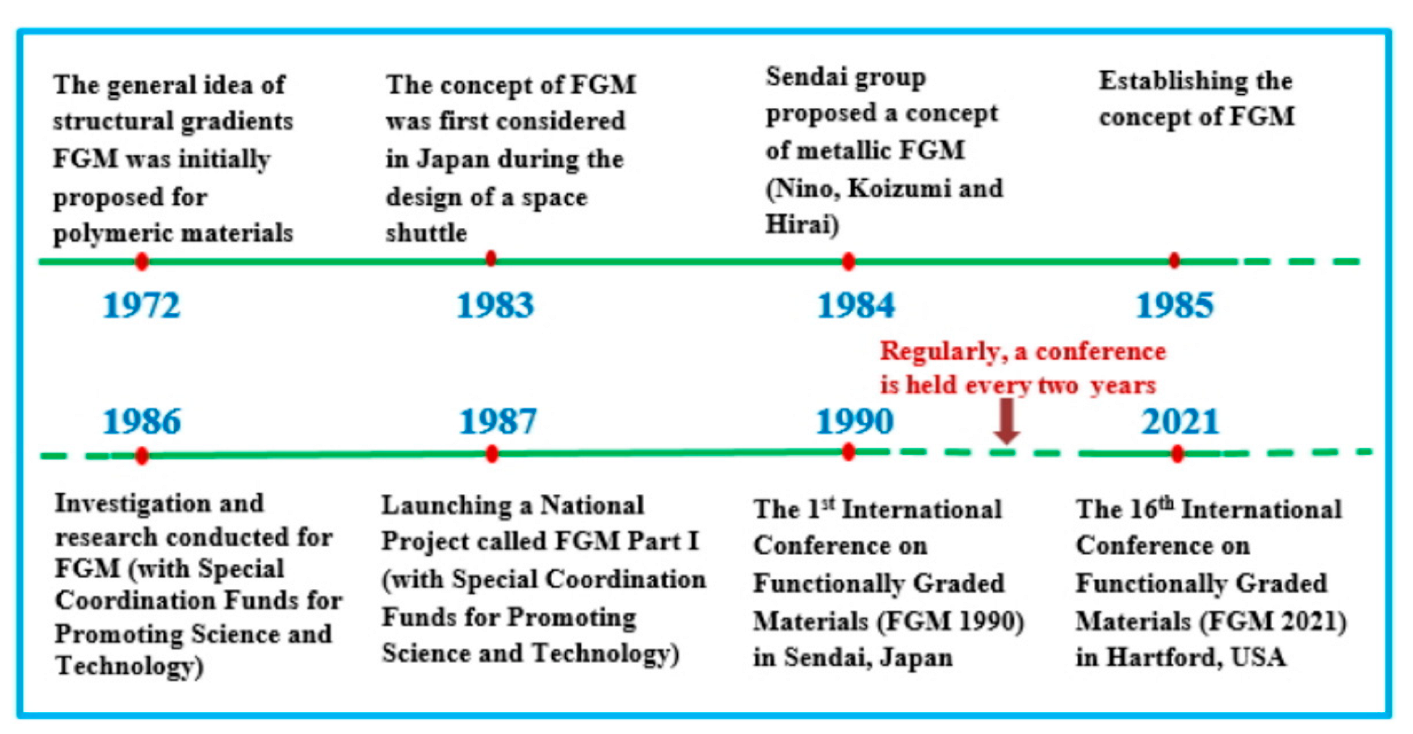
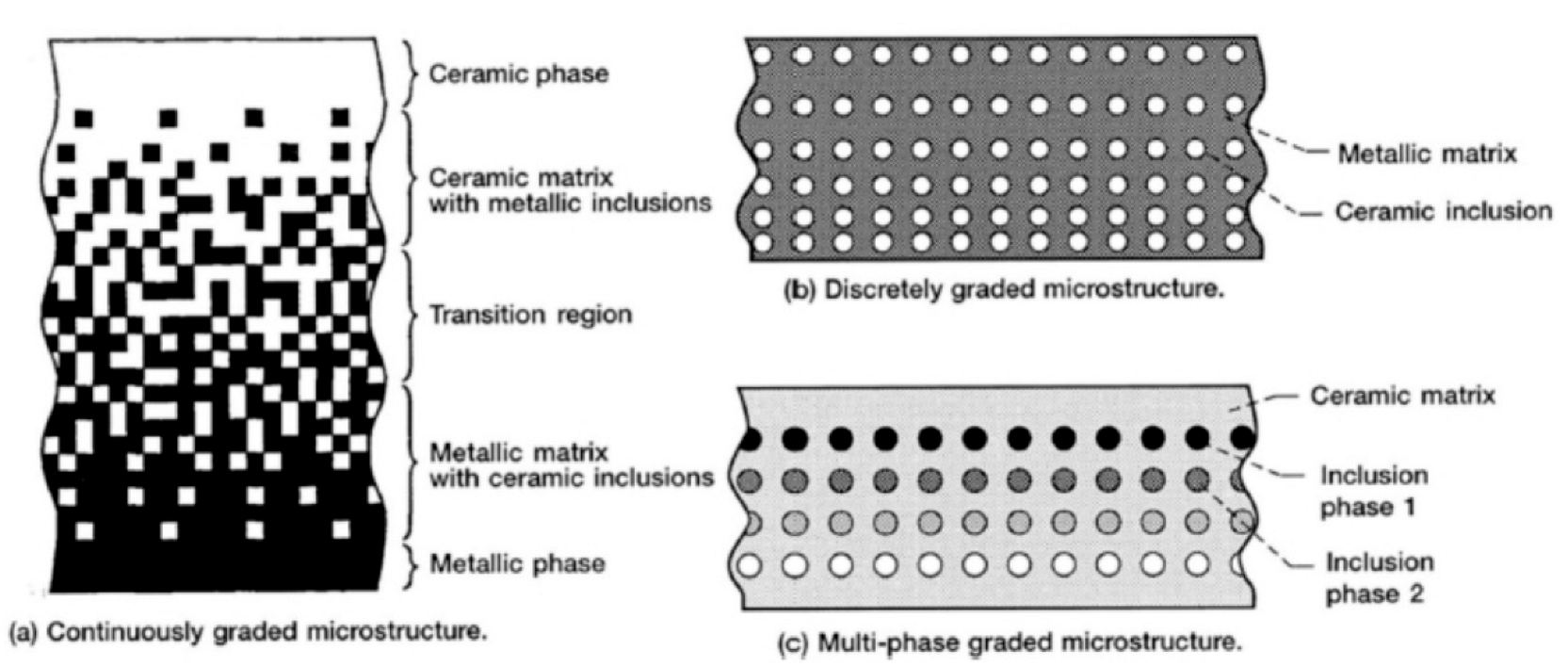
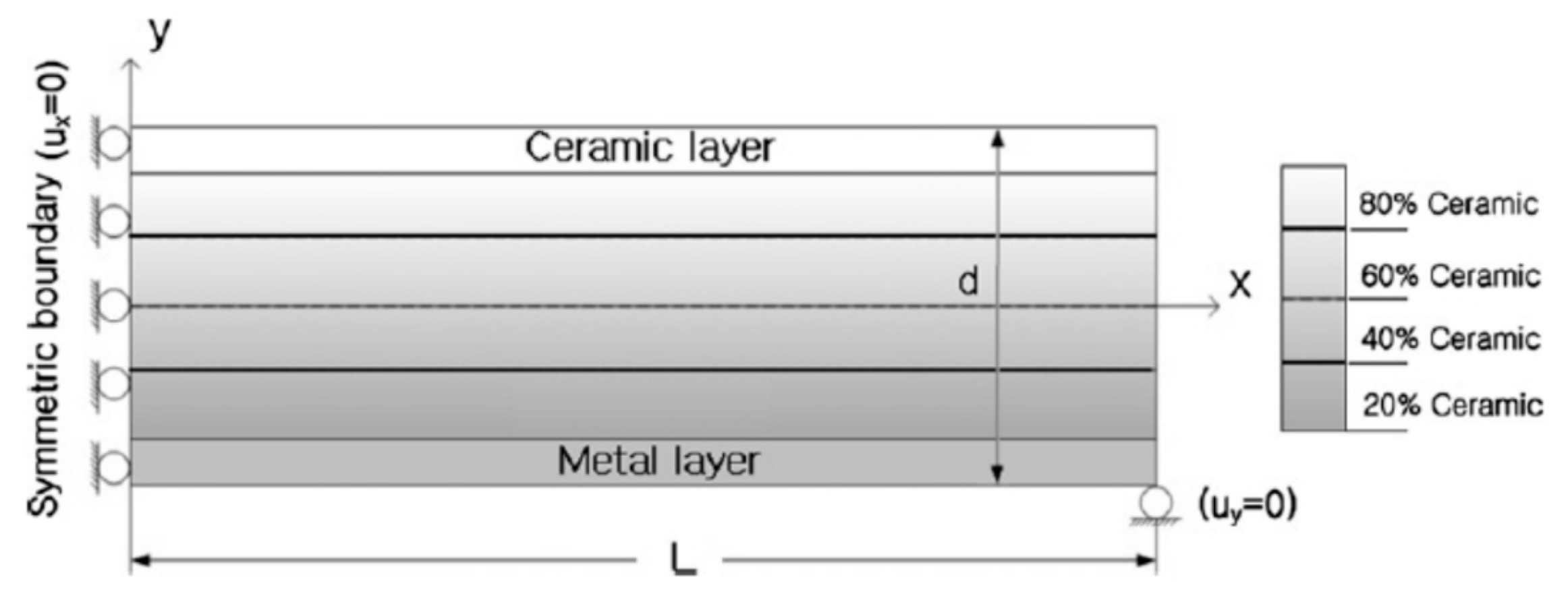
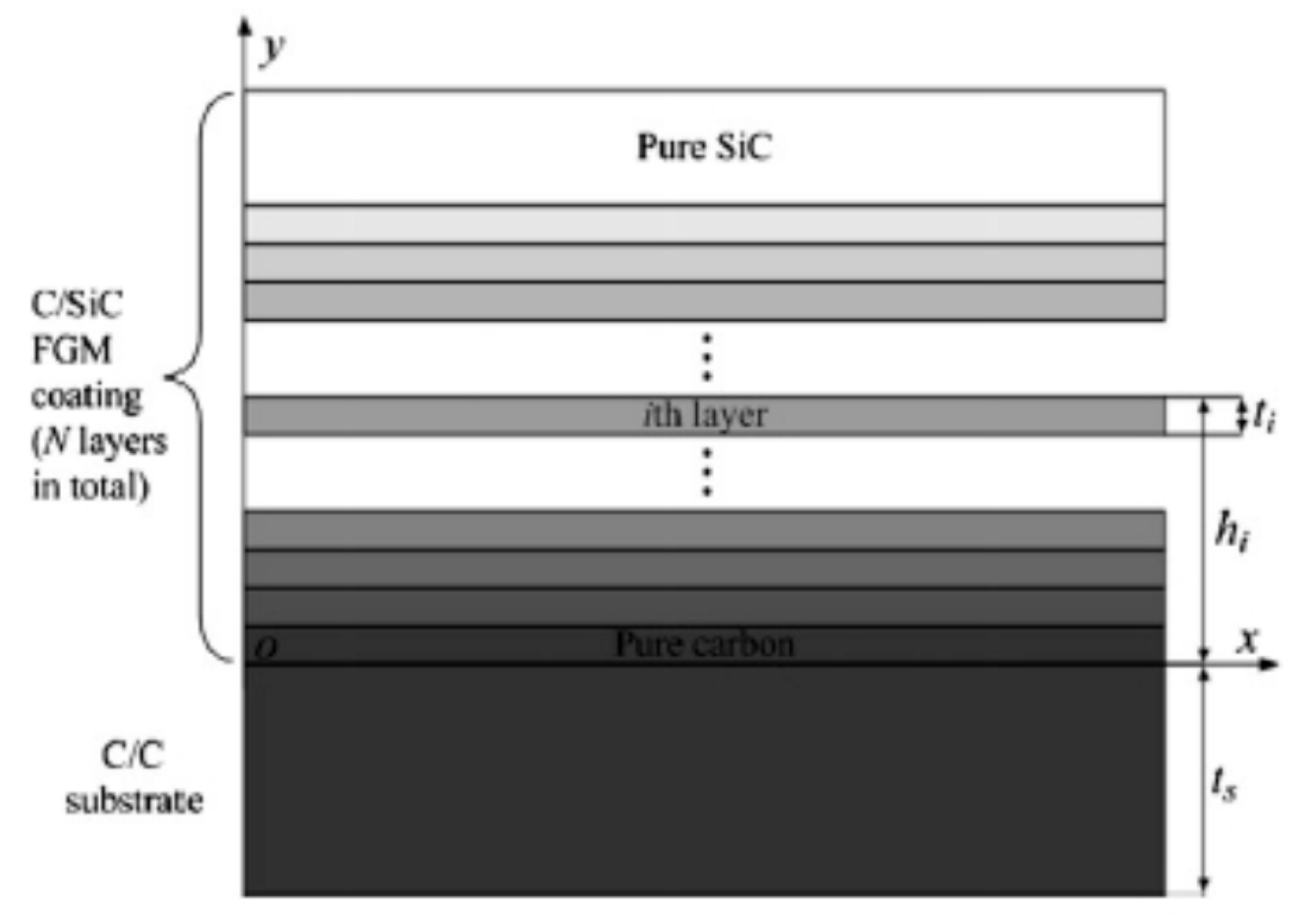
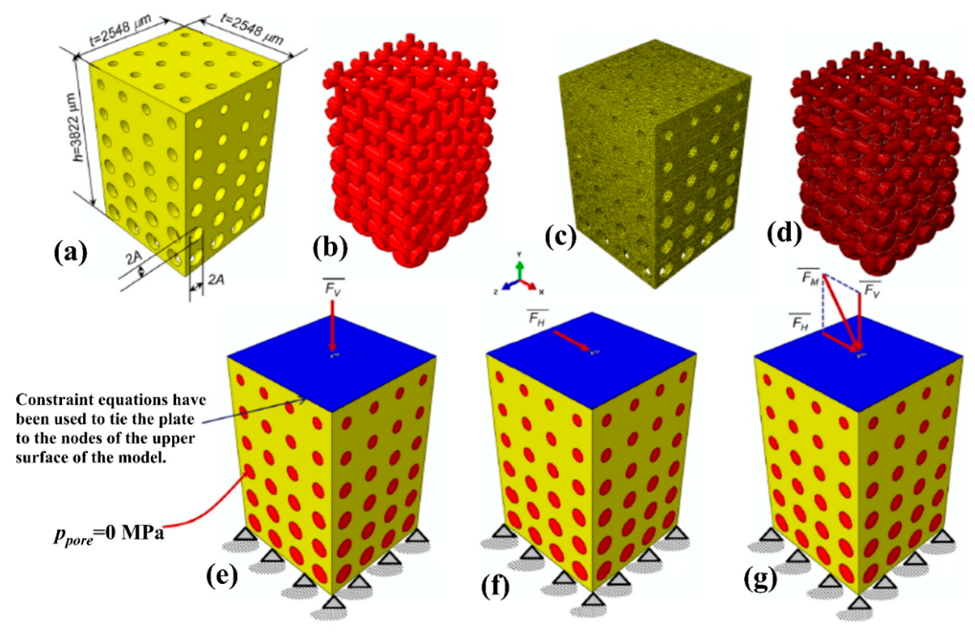
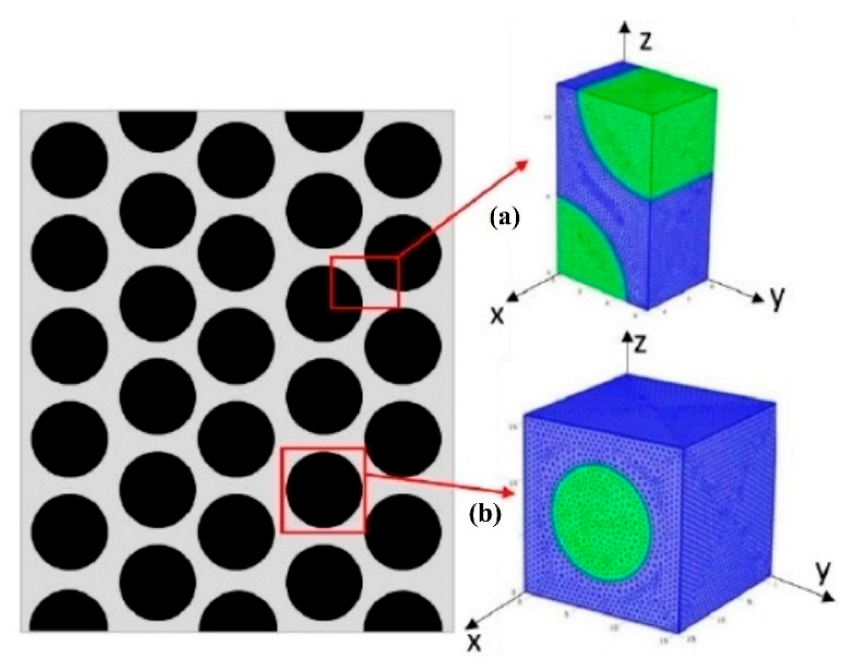
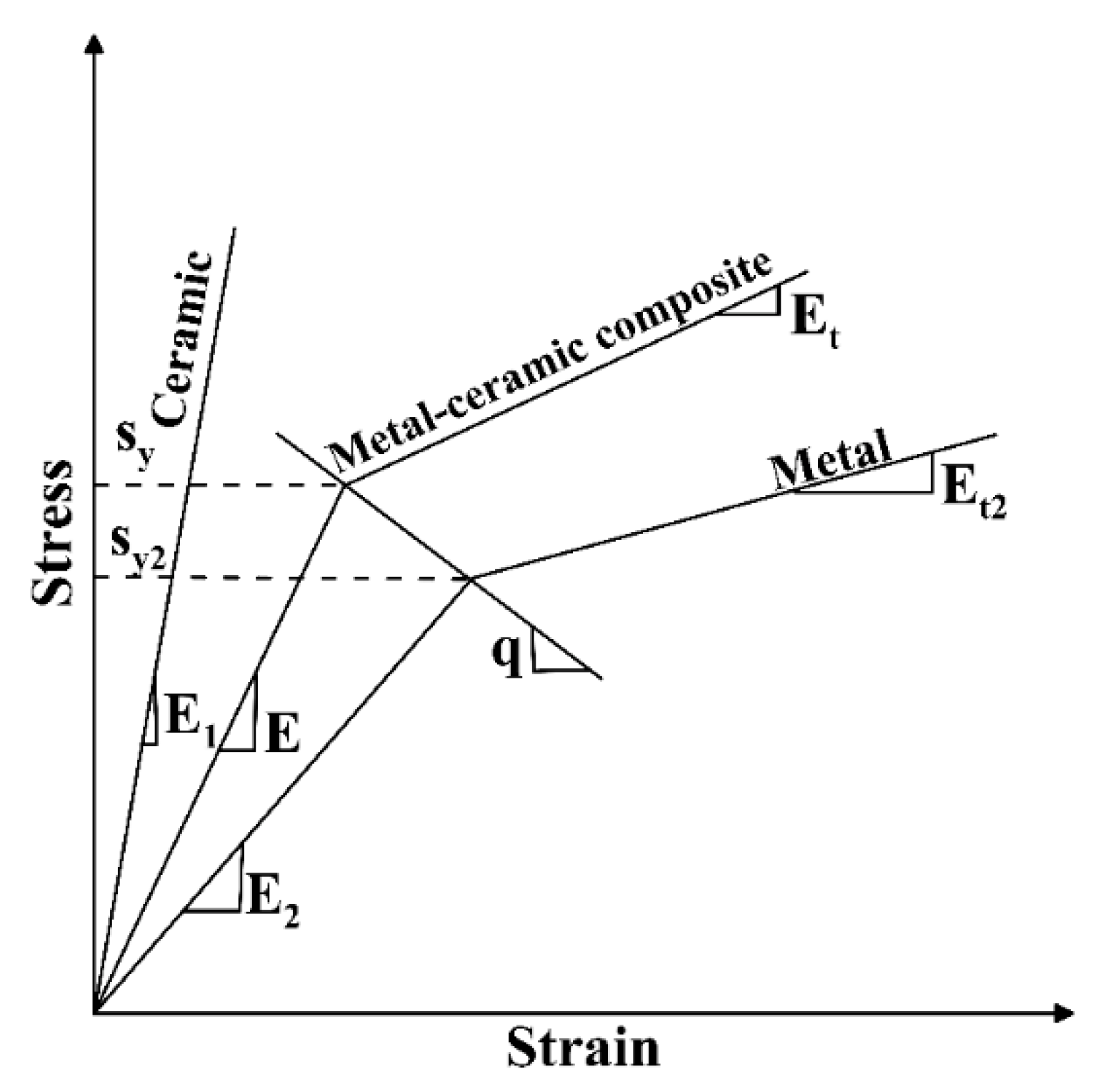


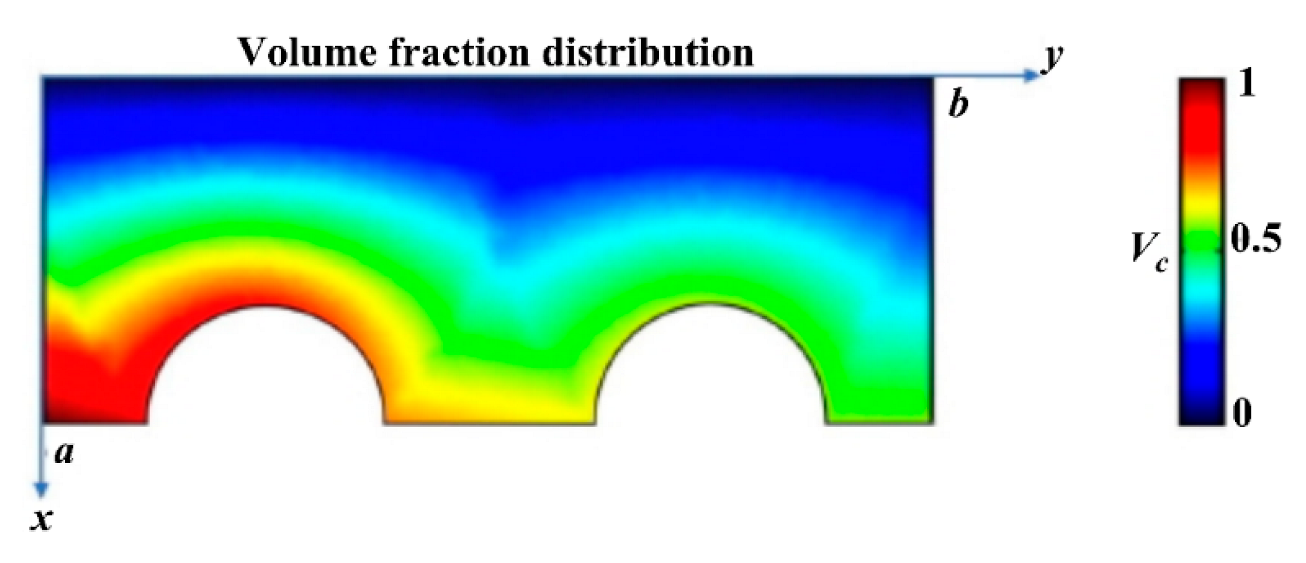

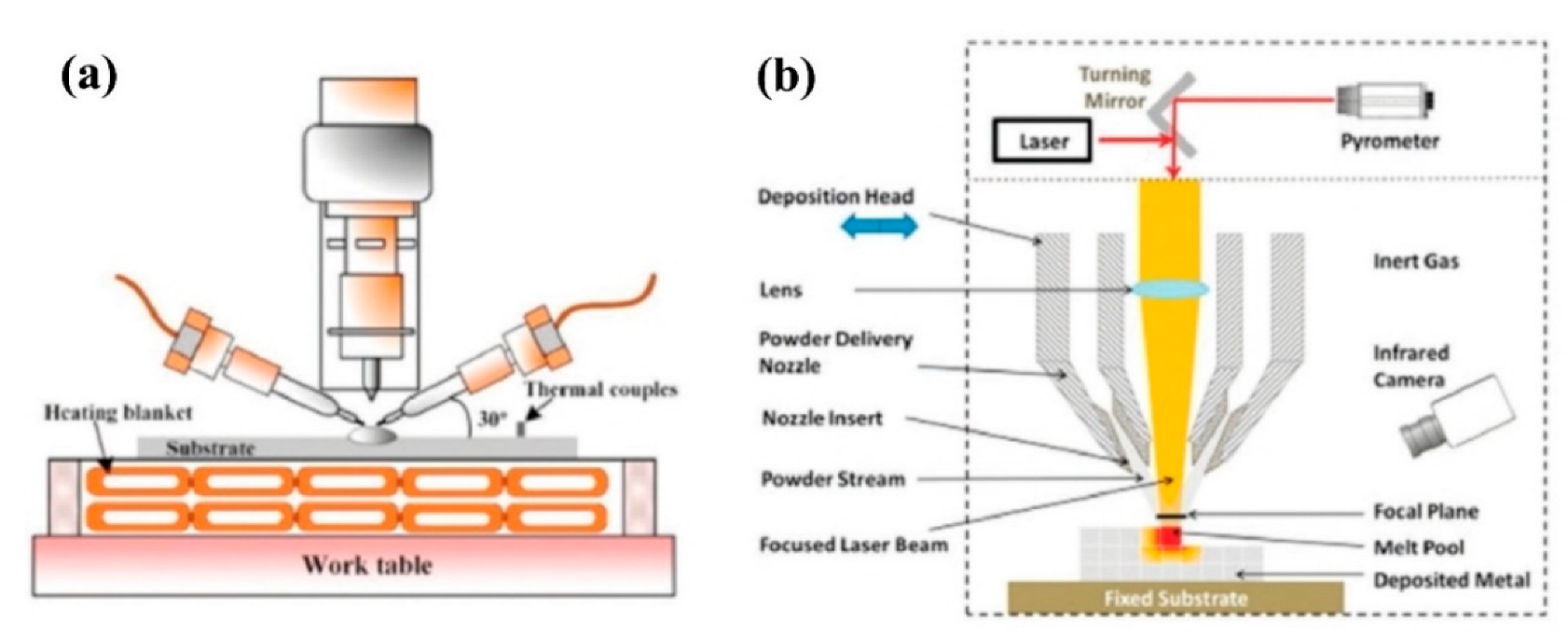


| Representations | Material Capability | Representational Capacity | Accuracy or Exactness | Compactness Overhead and Efficiency |
|---|---|---|---|---|
| Voxel model | A | ☆ ☆ ☆ ☆ | ☆ | ☆ ☆ ☆ ☆ |
| Volume mesh model | A | ☆ ☆ ☆ ☆ | ☆ | ☆ ☆ ☆ |
| Explicit function model | B | ☆ ☆ | ☆ ☆ ☆ ☆ | ☆ ☆ ☆ ☆ |
| Control point based model | B | ☆ ☆ ☆ | ☆ ☆ ☆ ☆ | ☆ ☆ ☆ |
| Implicit function model | B | ☆ ☆ ☆ | ☆ ☆ ☆ ☆ | ☆ ☆ ☆ ☆ |
| Hybrid composite model | B | ☆ ☆ ☆ ☆ | / | / |
| Handle Complex Geometry | Handle Complex Material Distribution | 1D,2D,3D Material Distribution | Handle Multi-Physics | Optimizing Geometry as Well | Realistic Material Model | Manufacturing Constraints | Convergence Speed | |
|---|---|---|---|---|---|---|---|---|
| Lieu and Lee [204] |  |  | 3D |  |  |  |  | Fast |
| Do. et al. [148] |  |  | 3D |  |  |  |  | Mediocre |
| Nayak and Armani [144] |  |  | 3D |  |  |  |  | Slow |
| Das and Sutradhar [92] |  |  | 1D |  |  |  |  | Mediocre |
| Jamshidi and Arghavani [207] |  |  | 2D |  |  |  |  | Fast |
| Banh et al. [208] |  |  | 1D |  |  |  |  | Fast |
Publisher’s Note: MDPI stays neutral with regard to jurisdictional claims in published maps and institutional affiliations. |
© 2022 by the authors. Licensee MDPI, Basel, Switzerland. This article is an open access article distributed under the terms and conditions of the Creative Commons Attribution (CC BY) license (https://creativecommons.org/licenses/by/4.0/).
Share and Cite
Nayak, P.; Armani, A. Optimal Design of Functionally Graded Parts. Metals 2022, 12, 1335. https://doi.org/10.3390/met12081335
Nayak P, Armani A. Optimal Design of Functionally Graded Parts. Metals. 2022; 12(8):1335. https://doi.org/10.3390/met12081335
Chicago/Turabian StyleNayak, Priyambada, and Amir Armani. 2022. "Optimal Design of Functionally Graded Parts" Metals 12, no. 8: 1335. https://doi.org/10.3390/met12081335
APA StyleNayak, P., & Armani, A. (2022). Optimal Design of Functionally Graded Parts. Metals, 12(8), 1335. https://doi.org/10.3390/met12081335







